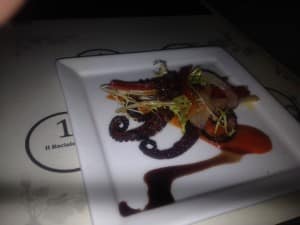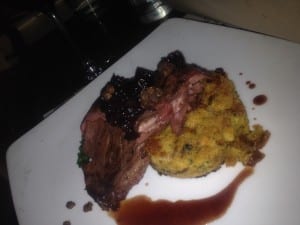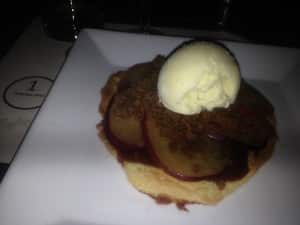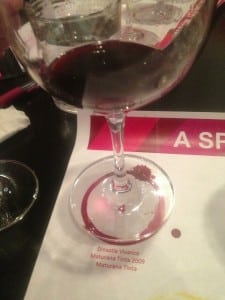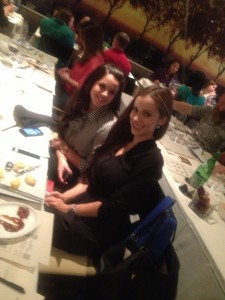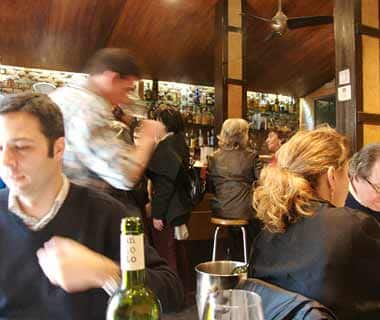Archive for the ‘Wine Bar’ Category
DC Wine Dinners to Savor: Braida Wine Dinner at Sonoma
Braida Wine Tasting and Three Course Wine Dinner – Legendary Italian Wines from Piemonte was held at Sonoma Restaurant on Friday, October 25th, 2013 and was a truly memorable event..

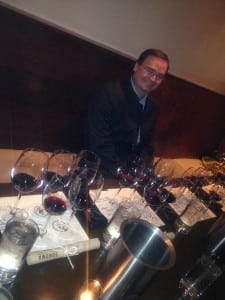 I really enjoyed this event with a family member of the Braida Winery in attendance – wine expert Norbert Reinisch, Braida’s Export Manager and Founder’s Son-In-Law. The tasting included Braida’s current releases of Montebruna, Il Baciale, Moscato d’Asti and Brachetto d’Acqui..But we also got to taste multiple vintages of Bricco dell’Uccellone and Ai Suma in a pre-dinner wine tasting that was fabulous! Norbert has in interesting personal story: he’s actually Austrian and began his career as a Doctor..somewhere along the line he fell in love with a member of the Braida Family and changed his career from internist to wine ambassador! As they say – tough job – now he gets to travel the world and promote his wine family’s wines and thell their story – I could think of worse jobs!
I really enjoyed this event with a family member of the Braida Winery in attendance – wine expert Norbert Reinisch, Braida’s Export Manager and Founder’s Son-In-Law. The tasting included Braida’s current releases of Montebruna, Il Baciale, Moscato d’Asti and Brachetto d’Acqui..But we also got to taste multiple vintages of Bricco dell’Uccellone and Ai Suma in a pre-dinner wine tasting that was fabulous! Norbert has in interesting personal story: he’s actually Austrian and began his career as a Doctor..somewhere along the line he fell in love with a member of the Braida Family and changed his career from internist to wine ambassador! As they say – tough job – now he gets to travel the world and promote his wine family’s wines and thell their story – I could think of worse jobs!
Pre-Dinner WineTasting
Monferrato Rosso Il Baciale 2011, $29.99
A blend of Barbera, Pinot Noir and I think Merlot – beautiful cherry fruit with a touch of pepper from the Pinot and some backbone from the Merlot
Barbera Bricco dell’Uccelone 2009, $84.99
Barbera Bricco dell’Uccelone 2010, $86.99
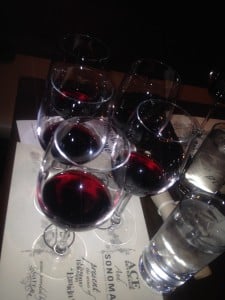 These two wines were both 100% Barbera but very different. The 2009 had amazing fruit-forward cherry and even a bit of baked apple fruit intensity, and oak was in the background but beautiful licorice/anise on the finish. The 2010 was tight and needs at least a few more years for the cherry fruit to break through the strong structure of French Oak tannins and red skin tannins as well which made this quite licorice on the finish and also a bit closed on the nose – this one will be much better 5 and even 10 years from now!
These two wines were both 100% Barbera but very different. The 2009 had amazing fruit-forward cherry and even a bit of baked apple fruit intensity, and oak was in the background but beautiful licorice/anise on the finish. The 2010 was tight and needs at least a few more years for the cherry fruit to break through the strong structure of French Oak tannins and red skin tannins as well which made this quite licorice on the finish and also a bit closed on the nose – this one will be much better 5 and even 10 years from now!
Barbera Ai Suma 2007, $121.99
Barbera Ai Suma 2009, $112.99
Again, these two wines were picked from the same vineyards, but from different vintages. From the intense aromatics to the first sip, the 2007 was just amazing on the palate with tons of cherry fruit, but also an added dimension – not just great acidity which Barbera is distinctly known for even in these hotter/riper vintages – but this wine had character and almost a brooding development of complexity. The tannins were there, but beautifully incorporated with fruit, oak and lush chewiness on my palate – I felt this wine luxuriously on my palate. The 2009 was also very good, but distintly had more chocolate, baked cherry pie and sweetness that surprised me a bit because it was younger. Make a note: these wines are both around 16% alcohol, so they are trophy wines that can stand-up competitively to top Bordeaux and Napa, but with so much more acidity to keep them refreshing!
Three Course Wine Dinner Menu
First
Fluke Crudo with preserved lemon, moscatto gelee, frisee and local asian pear
paired with 2012 Moscato d’Asti
Second
Grilled Duck Breast “Autunno” Duck, chicharonnes, Barbera cherry gastrique with savory pumpkin and sage bread pudding
paired with 2011 Barbera Monte Bruna
Third
Plum crisp with Local plums, brown sugar farro crumble and local goat cheese gelato
paired with 2012 Brachetto d’Acqui
 Little known fact: the grape varietal “Barbera” was once a throw-away jug wine kind of grape that was never taken very seriously in the Piedmont Region of Italy where Barolo and Barbaresco are the King and Queen of wines respectively. Guiseppe Bologna, the founder of Braida winery, was the first back in the 1980’s to produce prodigious wines by planting Barbera vines on his family’s land and using new French oak as his aging barriques.
Little known fact: the grape varietal “Barbera” was once a throw-away jug wine kind of grape that was never taken very seriously in the Piedmont Region of Italy where Barolo and Barbaresco are the King and Queen of wines respectively. Guiseppe Bologna, the founder of Braida winery, was the first back in the 1980’s to produce prodigious wines by planting Barbera vines on his family’s land and using new French oak as his aging barriques.
Categories: DC Events, Food and Wine Pairing, Restaurant, Uncategorized, wine and food pairing, Wine Bar, Wine Dinners, Wine Professionals
Tagged: Barbera, brand ambassador, Charlie Adler, d.c. wine, DC culinary, dc wine dinners, dc wine scene, Food and Wine Pairing, I Drink on the Job, idrinkonthejob, italian wines, maryland wine dinners, md wine dinners, tastedc, terroir, va wine dinners, virginia wine dinners, washington dc wine dinners, wine ambassador, wine consumer, wine consumption, wine dinners, wine education dc, wine pairing, Wine Tasting, wine tasting dc, Wine tasting descriptors
Ree Ohh Haaaa!
Wednesday, June 12th, 2013 I attended a fun wine tasting for the Trade put on by Vibrant Rioja who were showcasing the wine region at a tasting put on at Ripple Restaurant in Cleveland Park, Washington, D.C. Aaron Gordon was representing Vibrant Rioja and let’s just say – he’s a character! The wine trade always has attracted the artsy and the intellectual, and maybe the slightly off-center – I would say this guy fits the bill! The other speaker was a more traditional sommelier.. well almost David Denton who was also at one time a punk rock guitar player – but now he works as the sommelier at Charlie Palmer Steak on Capital Hill. But the presentation was very good – well, actually I couldn’t see the tv screen presentation (was it a slideshow?), but the layout of the wine tasting was really excellent and easy to follow – numbered glasses, white in front of red.
So what did I gain from this Rioja tasting?
-Tempranillo can be white – yes, I had probably my first white Tempranillo – and it was very good! I would say it was a medium-bodied white and I think it had some oak, but it was also unusual in that it was slightly oxidized even though it was a young wine – so it had those sherry-like features/burnt almond that made it seem much older.
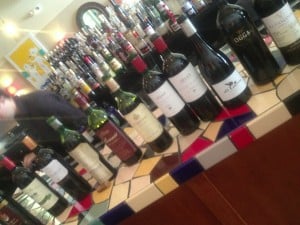 -there are many indigenous varietals I had never heard of and I tried one that made me pretty excited – Maturana Tinta – a gamey/blackberry fruit red grape that had quite a bit of life and a touch of gaminess! After tasting so many steady Cabernets and even Tempranillo’s in my wine tasting career, it’s always nice to find a red varietal that has life and potential – this wine (albeit this was a better-made more expensive version by Dinastia Vivanco (2009) shows how there is more great wine to explore even from well-known regions like Rioja.
-there are many indigenous varietals I had never heard of and I tried one that made me pretty excited – Maturana Tinta – a gamey/blackberry fruit red grape that had quite a bit of life and a touch of gaminess! After tasting so many steady Cabernets and even Tempranillo’s in my wine tasting career, it’s always nice to find a red varietal that has life and potential – this wine (albeit this was a better-made more expensive version by Dinastia Vivanco (2009) shows how there is more great wine to explore even from well-known regions like Rioja.
-a red wine over 10 years old isn’t necessarily brickish in color or aged in taste – I’m still amazed at the vibrancy and purple color of the Bodegas Ontanon Reserva 1995 (Tempranillo and Garnacha) – my understanding is that this wine had been kept in the winemaker’s cellar until recently which may explain alot – the color suggested a relatively young wine and the fruit was still noticeable on the palate, although there was quite a bit of that aged cedar box you get from slightly older wines. I think more than anything, Tempranillo can age amazingly well, but proper treatment and storage of your wines can make a HUGE difference when you go to open something over a decade old – consider improving or maintaining quality wine storage!
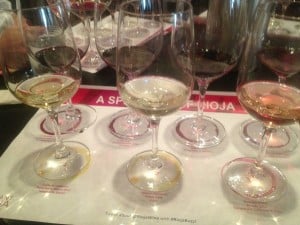 Overall, the event was very nicely laid out and had a festive feel. I also like the fact that they chose a wine bar – Ripple – vs. a traditional fancy schmancy fine dining restaurant – it gave this a more festive air. Rioja is almost an exclamation point for Spanish wine – you can simply walk in to pretty much and decent restaurant and ask for a “Rioja” and the server will know that you mean a Tempranillo from the region. Tasting Graziano, Garnacha, Maturana and many other varietals opens up this traditional wine region to new experiences. Also, the traditional blending of Cabernet and Merlot with everything is a choice here – some traditionalists in Spain are trying to bring more local character to their wines by avoiding the overly oak, rich, modern style. One last point – traditionally, Rioja uses American oak barrels vs French for aging of wines – this also gives them a slight “coconut” aromatic that sets them apart from other European wines. Cheers to Rioja!
Overall, the event was very nicely laid out and had a festive feel. I also like the fact that they chose a wine bar – Ripple – vs. a traditional fancy schmancy fine dining restaurant – it gave this a more festive air. Rioja is almost an exclamation point for Spanish wine – you can simply walk in to pretty much and decent restaurant and ask for a “Rioja” and the server will know that you mean a Tempranillo from the region. Tasting Graziano, Garnacha, Maturana and many other varietals opens up this traditional wine region to new experiences. Also, the traditional blending of Cabernet and Merlot with everything is a choice here – some traditionalists in Spain are trying to bring more local character to their wines by avoiding the overly oak, rich, modern style. One last point – traditionally, Rioja uses American oak barrels vs French for aging of wines – this also gives them a slight “coconut” aromatic that sets them apart from other European wines. Cheers to Rioja!
Charlie “I Drink on the Job” Adler
Categories: Charlie Adler, DC Wine Tastings, Uncategorized, Wine Bar, Wine Professionals, Wine Tasting
Tagged: Charlie Adler, d.c. wine, David Denton, dc wine scene, Graziano, I Drink on the Job, idrinkonthejob, Maturana, Range, Rioja, Ripple, Vibrant rioja, Voltaggio, Wine and food matching, wine basics, Wine Tasting, wine tasting dc, Wine tasting descriptors
A Cheesey Affair: Wine + Cheese Event at Black’s Bar & Kitchen
A Lazy Fall Saturday Afternoon..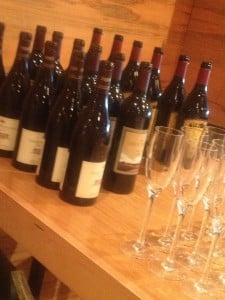
I attended a LivingSocial sponsored event “Wine + Cheese at Black’s Bar & Kitchen” (Bethesda, MD) on Saturday, November 17th, 2012 from 1 – 3 pm – actually, it was the first event I had attended through LivingSocial even though I had purchased many restaurant deals from them in the past. The event had 2 flights of cheeses, 12 cheeses in total and wines were paired with them, a total of 8 (See list of wines and cheeses with Photos below). It was a seated event and guided tasting with main presenter Chef Mallory Buford speaking about the cheeses and Black’s Sommelier Anderson Plunket discussing the wines. Chef Buford was very knowledgeable about cheese, but each cheese producer also had their own representative/distributor to talk about each cheese’s qualities. It was a nice combination of class and chance for people to talk amongst themselves – I would call it “lecture light” and more of a chance for people to try everything and make their own conclusions. This restaurant is really known for seafood so it’s kind of interesting that they decided to try a cheese and wine event – my understanding is that all of these cheeses are on their existing menu, so that makes sense..but don’t ask an Italian – they claim that seafood and cheese should never go together!
There were 12 cheeses and 8 wines:
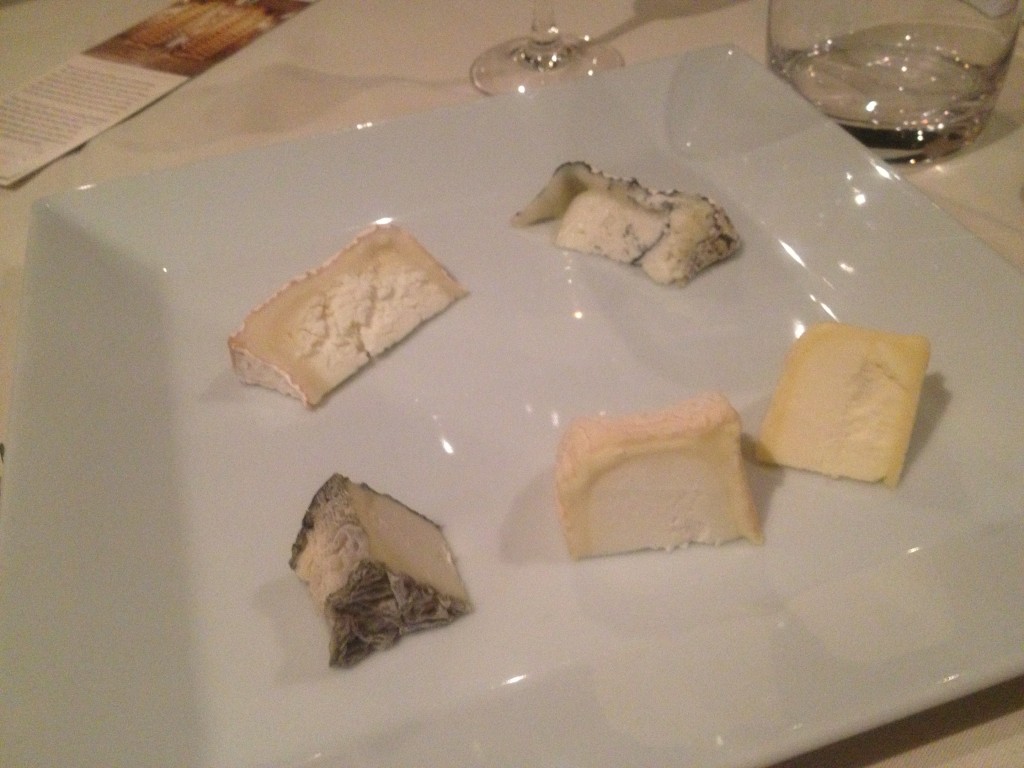 1st Cheese Flight:
1st Cheese Flight:
1)Cherry Glen Farms Monocacy Silver – Soft-Ripened Goat’s Milk
2)Cherry Glen Farms Monocacy Ash-Soft Ripened Goat’s Milk with Ash Rind
3)Vermont Butter & Cheese Bonne Bouche – Ash-Ripened Goat’s Milk
4)Vermont Butter & Cheese Coupole – Aged Goat Milk
5)Vermont Butter & Cheese Cremont – Aged Goat and Cow’s Milk
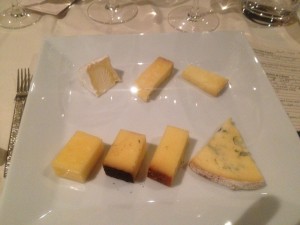 2nd Cheese Flight:
2nd Cheese Flight:
6)Jasper Hill Farm Weybridge – Organic Cow’s Milk
7)Jasper Hill Farm Cabot Clothbound Cheddar – English Style Cow’s Milk
8)Jasper Hill Farm Landaff – Semi-Firm Raw Cow’s Milk
9)Beehive Creamery Promontory – Irish Style Cow’s Milk
10)Beehive Creamery – Espresso and Lavendar Rubbed Cow’s Milk
11)Beehive Creamery – Cayenne Rubbed Cow’s Milk
12)Jasper Hill Farm – Raw Cow’s Milk Blue
Wine Pairings:
1)Prosecco, Tenuta S. Anna, NV (Italy)
2)Sancerre, Paul Prieur 2010 (Loire, France)
3)Pinot Gris, Elk Cove 2011 (Williamette Valley, Oregon)
4)Chardonnay, Windracer 2007 (Anderson Valley, CA)
5)Pinot Noir, Domaine Carneros 2010 (Carneros, CA)
6)Merlot, Truchard 2008 (Carneros, CA)
7)Cabernet/Syrah Blend, Treana 2009 (Organic) (Paso Robles, CA)
8)Riesling, Poet’s Leap 2010 (Columbia Valley, WA)
Charlie “I Drink on the Job” Adler
Categories: Cheese Event, culinary events, DC Wine Classes, DC Wine Tastings, Food and Wine Pairing, Foodie, Restaurant, tastedc, Uncategorized, wine and food pairing, Wine Bar, wine classes
Tagged: Anderson Plunket, artisanal cheese, b linens, Barely Buzzed, Bayley Hazen Blue, Beehive Creamery, bethesda, Big John's Cajun, Black's Bar & Kitchen, Bonne Bouche, Cabot Clothbound Cheddar, Carneros Winery, Carole Palmer, Charlie Adler, cheese and wine pairing, cheese tasting, Chef Mallory Buford, Cherry Glen Farms, chevre, Elk Cove Winery, farmstead cheeses, Food and Wine Pairing, goat's milk cheese, I Drink on the Job, idrinkonthejob, Jasper Hill Farm, Landaff, maryland culinary, maryland wine tasting, md culinary, Monocacy Silver, Sommelier, Vermont Butter & Cheese, Wine and food matching, wine and food pairing, wine basics, wine classes dc, wine education, Wine Tasting, wine tasting dc, Wine tasting descriptors
The Wine Bar Craze in the U.S.
I recently read this post and photo montage of great wine bars in the world from Travel and Leisure Magazine Europe’s Best Wine Bars and was amazed at the diversity of concepts. I’ve been contacting many wine bars in the Washington, D.C. area recently about their special events and educational wine class offerings and I’m noticing that they all have different concepts of what a wine bar should be. Some local wine bars have a chef and a full menu, while others simply serve charcuterie and glasses of wine. The majority have beer programs as well, but the commitment to beer varies across the board. Almost all have some type of specialty wine preservation system like Enomatic that uses Nitrogen or Argon as inert gases that displace air in the bottle and preserve the wine to some extent.
The question is how does one differentiate what designates a “wine bar” vs. a restaurant? If a restaurant has a bar and they primarily sell wine, does that make the restaurant a wine bar as well? If a wine bar has a chef and also sells wine, does that simply mean it’s a restaurant that sells wine as well? And what about the situation where a wine bar/restaurant also has a license to sell off-premise wine and beer – shouldn’t that be called a wine bartailer? In Virginia, there’s the interesting combination of a restaurant and a separate establishment next door of an off-premise wine retailer. Due to unusual laws, this allows consumers to walk into the wine store, purchase a bottle of wine and consume it next door in the restaurant dining area. Virginia doesn’t allow consumers to bring their own wine into a restaurant (also known as “corkage”) but it does allow these special establishments. These type of restaurants normally charge a fee for the privilege, but it is usually must cheaper to do this than to purchase a wine off a restaurant’s wine list.
I’m going to be doing more research into wine bars and their special event requirements as a I spend more time marketing my services as a wine professional for hire as a wine educator. Future blog posts will cover how wine bars increase their profitability through special events and special programs including private events. Hopefully, this information will help both existing wine bars and potential wine bar owners in their decision-making and will increase the quality and revenue generation of wine bars throughout the world – Cheers!
Categories: Wine Bar, wine classes, Wine Tasting
Tagged: Argon, bartailer, Charlie Adler, corkage, d.c. wine, enomatic, enoteca, idrinkonthejob, tastedc, Wine Bar, wine preservation, wine special events, Wine Tasting, wine tasting dc
